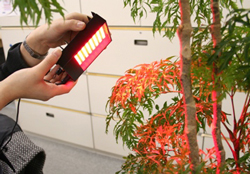
| Home | About Us | Contribute | Bookstore | Advertising | Subscribe for Free NOW! |
| News Archive | Features | Events | Recruitment | Directory |
| FREE subscription |
| Subscribe for free to receive each issue of Semiconductor Today magazine and weekly news brief. |
News
2 April 2009
SDK launches record-output 660nm AlGaInP red LED chips for plant growth
Showa Denko K.K. (SDK) has started selling samples of aluminum gallium indium phosphide (AlGaInP) LED chips that emit red light at 660nm, which is the optimum wavelength for accelerating the growth of plants.
 By developing a new light-emitting layer, SDK has achieved what it reckons is record output for a 660nm LED chip of 11mW at a drive current of 20mA.
By developing a new light-emitting layer, SDK has achieved what it reckons is record output for a 660nm LED chip of 11mW at a drive current of 20mA.
Picture: Lamps using the newly developed LED chips.
In recent years, facilities for growing vegetables in an environment of controlled lighting, temperature, humidity, CO2 concentration and nourishment have been attracting attention, as they ensure stabilized production regardless of the season or location, realizing multiple cropping. Furthermore, because of the controlled environment, they do not need fungicides or insecticides. Almost 30 facilities of this kind are already in operation in Japan.
It has been found that red light with a wavelength of about 660nm is most effective in increasing the efficiency of photosynthesis, accelerating the growth of plants. Currently, fluorescent lamps, sodium lamps, and conventional red LED lamps are being used at plant growth facilities. However, fluorescent and sodium lamps emit a great deal of light with wavelengths other than around 660nm, and conventional red LED lamps need to use many chips because of their low output, says SDK. As a result, these conventional light sources involve problems of energy loss and high costs. Also, the wavelength of conventional AlGaInP LED chips is 650nm at best, falling short of the ideal wavelength of 660nm.
In addition to the development of the new 660nm light-emitting layer, SDK says that it has improved the shape and arrangement of electrodes as well as the chip surface treatment method. Thus, the external quantum efficiency of LED lamps using the new AlGaInP chips is about three times that of conventional red LED lamps, it is reckoned. Compared with conventional red LED lamps, the new AlGaInP LED lamps reduce power consumption by 70% at a given level of brightness, resulting in lower cost and energy consumption at plant growth facilities, SDK claims. Also, lower heat emission from light sources should improve the plant growth environment.
SDK says that it will step up marketing activities for the new AlGaInP LED chips, while enhancing their performance to meet diversified needs from customers.
Under its ongoing Passion Extension project, SDK is expanding its ultrabright LED chip operation—consisting of AlGaInP red LED chips and indium gallium nitride (InGaN) blue/green LED chips—as a growth-driver business. The firm says that it is preferentially allocating resources to these areas in an effort to further increase its corporate value.
See related item:
SDK starts shipping 80lm/W red LED chips
Visit: www.sdk.co.jp
